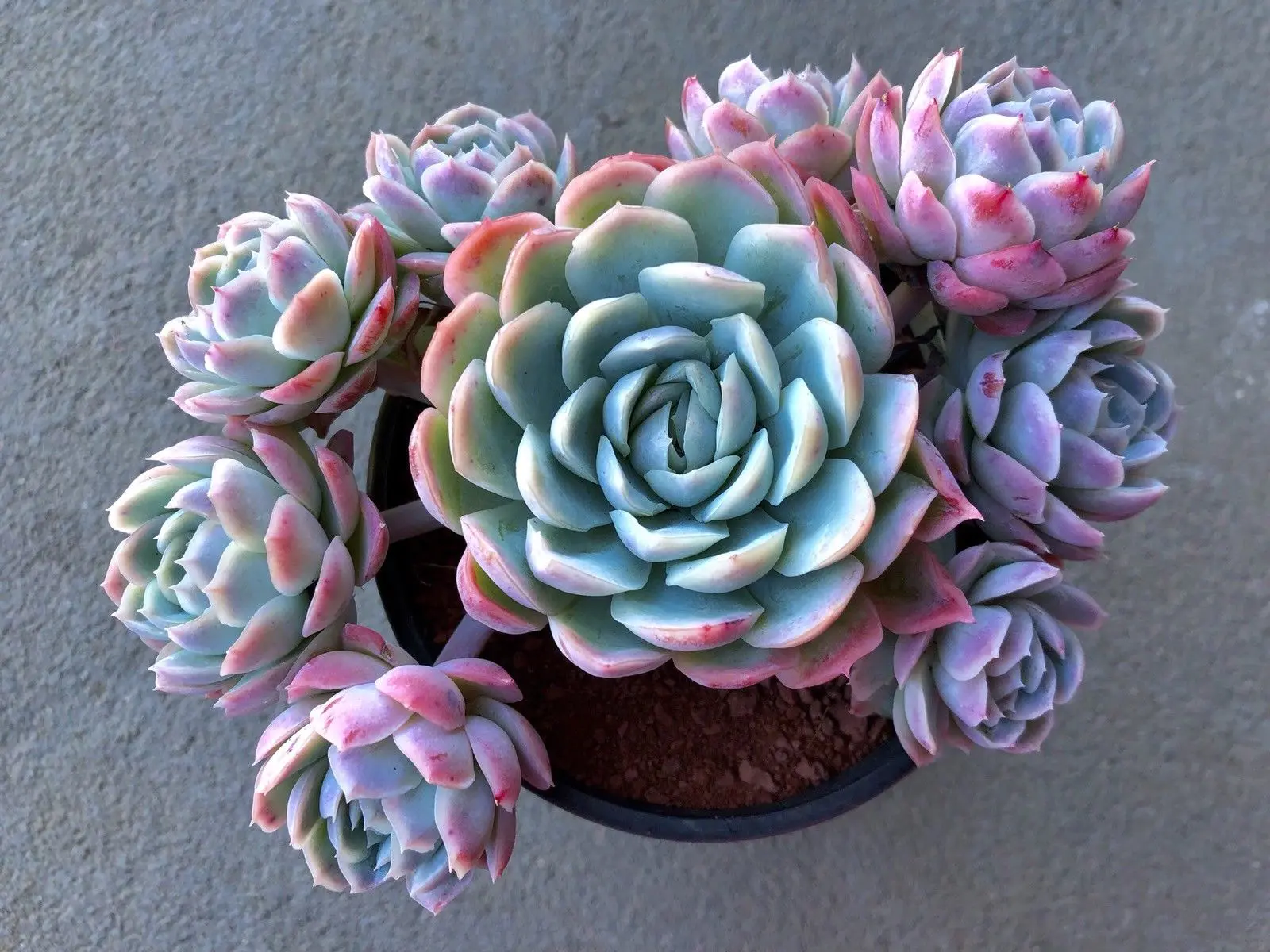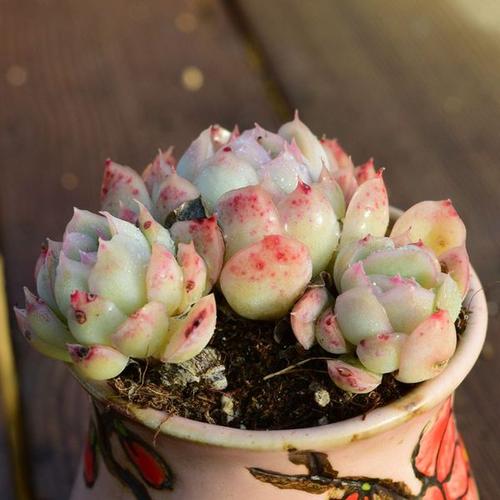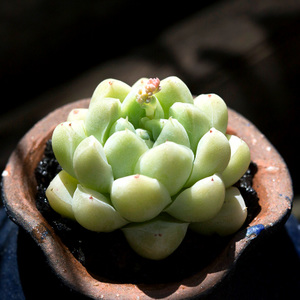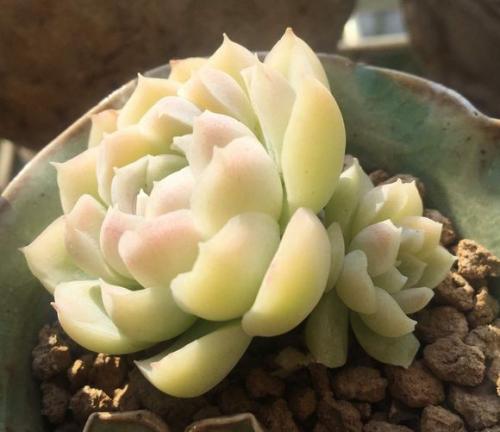Echeveria Elegans (Mexican Snowball) Profile - Grow and Propagation
Written by Maggie
Nov 12 2021

Echeveria Elegans is a horticulture species of the genus Echeveria in the family Chrysomelaceae. Echeveria Elegans succulent is known as Mexican Snowball. The leaves of the plant are closely arranged in an annular pattern, spoon-shaped, with small leaf tips, and the whole plant leaves are slightly closed towards the center. Smooth leaves of Echeveria Elegans are with micro white powder, leave all the year-round pale green, translucent leaf edge. When the temperature difference is large, the plant against the white powder on the leaves, is particularly lovely.
Echeveria Elegans Picture

Echeveria Elegans Quick Info
| Botanical/Scientific Name | Echeveria Elegans |
| Common Name | Mexican Snow Ball |
| When to Grow/Bloom/Harvest | Bloom from spring to summer |
| Uses | Ground cover |
| Origin | Mexico |
| Light Care | Gets 6 hours of sunlight a day |
| Soil Care | Good drainage and medium to dry moisture |
| Temperature Care | 20° degrees Fahrenheit to 50° degrees Fahrenheit |
| Humidity Care | Dry room humidity (40% relative humidity or lower). |
| Watering | Watered sporadically |
| Pruning Care | Simply prune stems |
| Fertilizer Care | Balanced liquid fertilizer 2-3 times during spring and summer months |
| Propagation | Leaf propagation |
| Toxic | No toxic effects reported |
| Flower Color | Pink flowers, tipped with yellow |
Echeveria Elegans Habits
Echeveria Elegans succulent (Mexican Snowball) has strong habits and is easy to maintain. The suitable temperature is 10~25℃. During the spring growing season, the watering frequency can be 1-2 times a week. Summer should be an appropriate shade, pay attention to risk control water, overall maintenance is not difficult, summer is relatively easy.
Echeveria Elegans Characteristics
Echeveria Elegans succulent (Mexican Snowball) almost has no stem. Leaves of echeveria elegans are dense, oblong-obovate or obovate-cuneate, mucronate, upper surface flat or concave, 7 -- 7.5 x 1 -- 3.5cm, thick; Echeveria Elegans is almost white, or greenish frosted, sometimes with purplish edges.
Inflorescences are unbranched, 10 -- 15 cm tall, pedicels to 6 -- 10 mm.
Flowers: Sepals of Echeveria elegans succulent (Mexican Snowball) are 5 -- 10 mm, adnate or spreading, corolla tapered, 11 -- 18 x 8 -- 12 mm in diameter, pinkish to glaucous at the base, usually yellowish or green at the apex.
Echeveria Elegans Distribution
Echeveria Elegans succulent (Mexican Snowball) is wildly distributed in Mexico Hidalgo, San Luis Potosi, Guanajuato, Queretaro, Jalisco and other places.

Echeveria Elegans Care in Different Season
In spring and autumn season
The spring and autumn season is the main growth period of Echeveria Elegans succulent (Mexican Snowball). At this time, the temperature difference between day and night is big, the light is sufficient, the ventilation is good, especially the morning and evening dew is conducive to the growth of stone lotus. We can open doors and windows of the greenhouse, and removed the sun-shade net, to strengthen the light and increase the temperature difference between day and night, make it a more compact plant type, the white powder on the surface of the laid denser, the color of Echeveria Elegans is more bright-colored, otherwise Echeveria Elegans will lack light, the small temperature difference between day and night, cause the plant type is loose, and the red varieties cannot appear red, hairy varieties of hair grow thin, color and luster is dim, slender leaves thin, etc., these will affect their appreciation.
In the Echeveria Elegans succulent (Mexican Snowball) growing season, we should master the "do not do not pour, pour then pour thoroughly" watering principle, avoid basin soil deeper, can rot root otherwise, but air humidity can be slightly bigger. When the air is dry, water can often be sprinkled around the plant to increase air humidity, but the leaf, especially the center of the leaf cluster, should not be water, so as not to rot. No matter when should avoid rain drench, especially long-term rain drench, otherwise the plant is bibulous overmuch, leaf, rhizome epidermis organization can be held by mesophyll organization crack, cause bacterial sex infection and rot. During the Echeveria Elegans growing season, apply decaying thin liquid fertilizer or "low nitrogen and high phosphorus and potassium" compound fertilizer every 20 days or so. When fertilizing, do not splash the fat water on the leaves. Fertilization is generally carried out in the morning or evening when the weather is fine. In the evening of the same day or in the morning of the next day, a flood is poured to dilute the residual fertilizer liquid in the soil.
In winter season
In winter Echeveria Elegans succulent (Mexican Snowball) should be given enough sunshine, if the minimum temperature at night at about 10 degrees C, and there is a certain temperature difference between day and night, can be properly watered, as appropriate fertilization, so that the plant continues to grow. If these temperatures cannot be maintained, control watering, keep the potting soil dry, stop applying fertilizer and put the plants to sleep. This will allow the plants to withstand temperatures of 0 ° C or even lower.
Turn the basin once every one or two years, in spring or autumn, the basin soil requires loose and breathable, with good drainage and appropriate granularity. It should be noted that Echeveria Elegans do not belong to fleshy root flowers, cultivation soil should not be too granulated, should choose about 1 mm, rich in humus fine sandy soil cultivation. Available leaf soil 3, 3 river sand, garden soil 1, slag 1 mixed preparation, and mixed with a small amount of bone powder and other calcium materials, and sieving, sieving to too fine soil. When turning over the pot, cut off the old roots of Echeveria Elegans, cut the old roots short, and prune the old lignified coils appropriately to promote strong new roots. Replant with new soil. In order to be beautiful, still can spread a layer of stone or ceramsite and other granular material in the basin surface.
Echeveria Elegans Care in Detail
Echeveria Elegans Watering
Echeveria Elegans should be watered dry rather than wet. It must be watered permeable after drying, not too wet. Generally, watering once or twice a month is enough. It is best to use rootless water. In winter, it should be carried out when the temperature is high at noon. It should be noted that Echeveria elegans generally has many leaves and compact arrangement, so excessive watering on the leaves should be avoided as far as possible during watering, otherwise it is easy to accumulate water and cause leaf decay. If we accidentally accumulate water in the leaf center, we should put Echeveria elegans in a ventilated place and dry it as soon as possible.
Echeveria Elegans Soil
Echeveria elegans is suitable for growing in loose and well-drained soil. When preparing soil, we can mix more than 50% particles into peat soil to increase soil drainage and reduce rotten roots. If we want to increase the fertility of Echeveria elegans soil, we need to mix a small amount of bone meal.
Echeveria Elegans Light
In summer, Echeveria elegans should be properly shaded. Every morning or after the sun sets, it can be placed at the scattered light for 2-3 hours to prevent overgrowth. It grows rapidly in spring and autumn, so it is necessary to supplement enough light, so that Echeveria elegans can grow in a good state. The plant type is compact and lovely, the leaves are plump and plump, and the leaf tips are easy to be stained with a faint blush.
Echeveria Elegans Temperature
Echeveria elegans likes to grow in a dry and warm environment rather than high temperature and muggy. The suitable growth temperature is about 10-25 degrees. Echeveria elegans can't stand the cold. In winter, it is kept in a warm room to raise the temperature to more than 10 degrees to ensure normal growth.
Echeveria Elegans Humidity
It is necessary to properly create the air humidity of Echeveria elegans, but on the premise that it does not violate nature, try to make use of the surrounding environment and existing facilities. For example, it is dry in autumn, we can close the window after watering in the evening to moisturize, it is wet outdoors in summer, we can open the window to let the outside moisture in, and so on, even if there is a simple flower shed, Always open the cover to maintain ventilation.
Echeveria Elegans Fertilizer
Echeveria elegans has small plants and has no special demand for fertilizer. It only needs to apply base fertilizer well, combined with watering in spring and autumn, and apply fertilizer once a month. We can add an appropriate amount of microbial agent and special fertilizer for meat in the soil when we go to the pot, which can promote the growth of meat root system, make the leaves plump and plump, and reduce diseases and pests.
Echeveria Elegans Pruning
In order to avoid tipping, they need to prune their heads every two to three years to shorten the stems. If handled properly, the remaining stems will grow more pistachios. Once the size is appropriate, ordinary cutting can be carried out. Before we go to Echeveria Elegans pruning, we need to break off the leaves of succulent plants near the knife, and the broken leaves can also be inserted, which will not be wasted at all. The mother plant after pruning was dried and then fed with water for growth. Don't get water from the wound, which can avoid that sometimes the cut tissue is too tender and dehydrates quickly.
Echeveria Elegans Repotting
If we want Echeveria elegans repotting, we can check whether there are new roots in the roots of Echeveria elegans? Is there any damage? Moreover, the root system in the whole flower pot is not too crowded, so it can be planted directly in the pot. Just scatter the new roots around and bury them directly in the soil of the new flower pot.
When planting, it is the same as before. The soil should be prepared with good air permeability as much as possible, and the particles should be more than half as much as possible. In this way, it can be cultivated directly. As long as the root system is dried, it can be watered directly for cultivation. Don't use too large pots. Use clay pots with good air permeability as much as possible, water and pour some rooting liquid into them, and put them in an environment with good light scattering and ventilation after watering, Echeveria elegans will grow roots quickly and directly. In a week at most, you will find that its leaves have been restored to full. In another week, Echeveria elegans will begin to grow. There are obvious growth marks at the growth point. It seems to grow faster, so we can water and fertilize it regularly and put it in a place with sufficient light, Normal maintenance is OK. This is the method of Echeveria elements repotting.
Echeveria Elegans Pest & Disease Control
Rust
Echeveria elegans is spotted on the surface. In fact, it is fleshy and rusty. In the early stage of the disease, the plant epidermis will produce edema like spots, with yellow and auburn in the center, and gradually expand around, just like putting a rust coat on Echeveria elegans. It is caused by the infection of core rust caused by Echeveria elegans disease, which is easy to be caused by improper cultivation and management, such as too barren basin soil, insufficient nutrients, poor long-term ventilation of potted plants and direct watering on the top of plants.
Fleshy Gray Gangrene
This is an important disease endangering Echeveria Elegans. The symptoms of gray gangrene are round or nearly round spots on stem nodes or stem balls, with a diameter of 4 ~ 8 mm, light brown to gray white, with small black spots on them, arranged in wheel shape, and orange red slimy spores when wet. There are often chlorotic halos around the disease spots. With the development of the disease, the whole is light brown and rotten.
Leaf mite
The occurrence of Echeveria Elegans disease will lead to a large black and red area. We can see cobwebs, especially when it is sunny and hot after the rain. It is a high incidence period, mainly sucking the juice of young stems and leaves with mouthparts, and the injured leaves appear yellowish-brown spots or withered and fall off.
Echeveria Elegans Propagation
Propagation of Echeveria Elegans succulent (Mexican Snowball) can be done by dividing plants, transplanting leaves, transplanting stems and sowing seeds.
Separating echeveria elegans succulent (Mexican Snowball) can be carried out in combination with turning over the pot. The method is to take off the small plants that grow next to the old plants, but those with roots directly into the pot, and dry those without roots for a few days. After planting, they can survive.
Leaf insertion of Echeveria Elegans can be carried out in the growing season, take a thick and full of complete leaves, air 3 days to 5 days later, oblique insertion or flat in the soil, let the base and the soil closely combined, after spraying water in the half shade conservation, keep the soil half dry, soon the base will take root, and grow buds.
Cuttings of Echeveria Elegans succulent (Mexican Snowball) can be cut with leaves of stem branches, some not easy to grow side bud varieties, the top of the rosette plexus can be cut, a few days after the cuttings, the remaining part is still in the soil, soon the residual stem will grow a lot of buds, such as these small buds grow up and then break off cuttings.

Echeveria Elegans Benefits
Echeveria Elegans can purify the air and is very beautiful. Planting Echeveria Elegans potted plants indoors also has the effect of purifying the air. In addition to being planted alone, multiple plants can also be placed together for joint planting, set off by several relatively natural white stones, and sprinkle a layer of fine gravel to create a desert feeling.
Finally, the most important thing is that no matter how it is placed, on the basis of increasing the ornamental, we can put Echeveria elements in a sunny place for regular management, remove some plants in poor growth conditions and replant plants with relatively good growth.
Read Next:
Echeveria Elegans Mexican Snowballs Care & Growing Guide
Echeveria Laui (Echeveria Succulent) Care Guide
Echeveria Agavoides Care & Propagation
Echeveria Pulvinata (Chenille Plant) Care & Propagation Guide
Echeveria Nodulosa (Painted Echeveria) Care Guide
Echeveria Imbricata (Blue Rose Echeveria) Grow & Care Guide
Echeveria Setosa: Grow & Care for Mexican Firecracker
Echeveria Black Prince Succulent Grow & Care Guide
Echeveria Runyonii Topsy Turvy Grow & Care Guide
Echeveria Takasago No Okina Care Guide
Latest Updated
- Benefits of Bugleweed - 7 Science-backed Health Benefits
- Bugleweed Dangers & Side Effects - Is It Poisonous?
- How to Plant Evergreen Trees - What You Should Know
- When to Plant Evergreens - Grow Guide for Evergreen Trees
- 12 Wonderful Evergreen Shrubs for Your Garden
- 12 Popular Evergreen Plants with Pictures for Beginners
- When And How To Prune A Lilac Bush Like a Pro
- How to Grow & Care for Lilac Vine (Hardenbergia Violacea)
- Japanese Lilac Tree (Syringa Reticulata) Care & Propagation Guide
- Shumard Oak Pros and Cons - What to Know
Popular Articles
- Winter maintenance of Antirrhinum Majus
- How to Grow Terminalia Mantaly Tree
- How to Grow and Care for Crossostephium Chinense
- How to grow Antirrhinum Majus in spring
- Peristeria Elata (Dove Orchid) Profile: Info & Care Guide
- Underwatered Snake Plant (Sansevieria Trifasciata) - Signs And How To Fix
- How to Care for Brazilian Jasmine Plant (Mandevilla Sanderi)
- How to Grow & Care for Graptopetalum Purple Delight in Summer
- Rosa Chinensis (China Rose): Plant Growing & Care Tips
- How to Care for Baby Sun Rose (Aptenia Cordifolia)